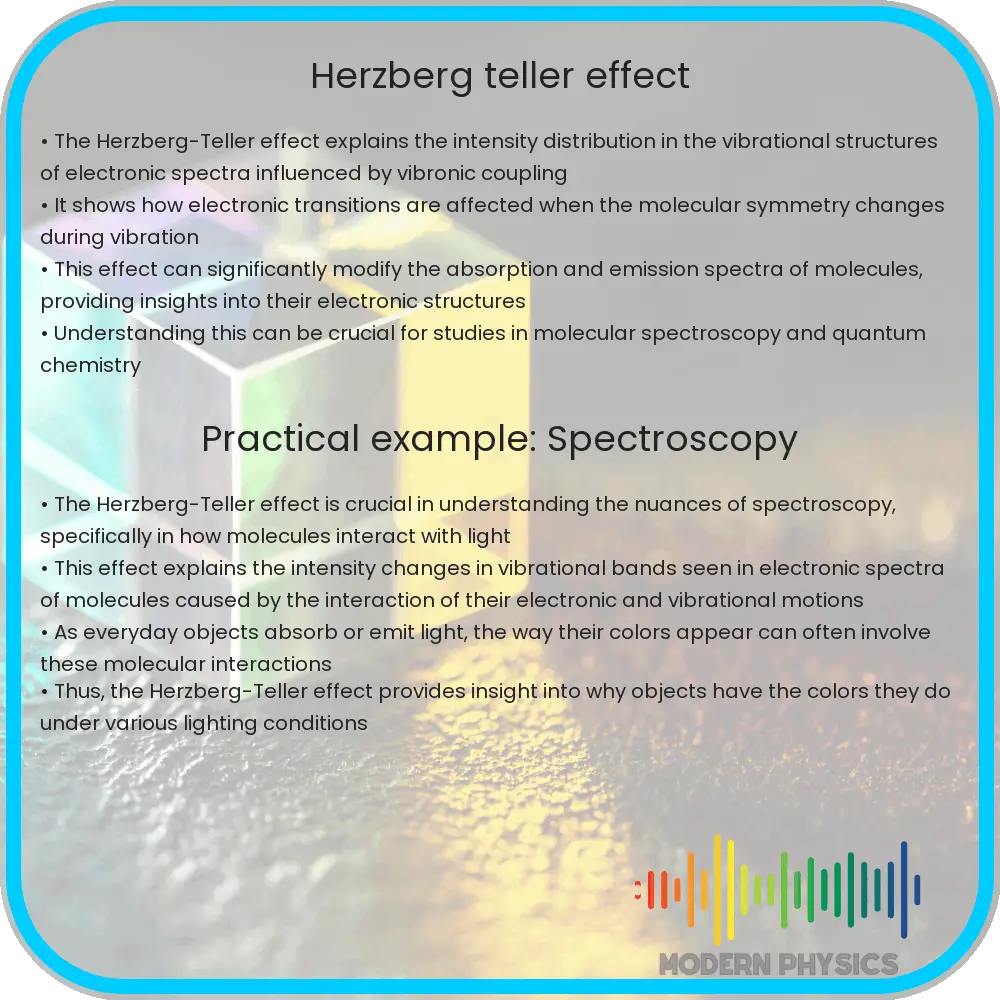Learn about the Herzberg-Teller effect in spectroscopy, which explains the influence of vibrational motion on electronic transitions in molecules.

Understanding the Herzberg-Teller Effect in Spectroscopy
The Herzberg-Teller effect is a fascinating phenomenon in the field of spectroscopy, particularly crucial in understanding the intensity variations in the vibrational spectra of molecules. This effect generally comes into play when considering how electronic transitions within a molecule are influenced by its vibrational motion. Let’s explore what this means and why it matters in the world of molecular spectroscopy.
Basics of Electronic and Vibrational Transitions
To comprehend the Herzberg-Teller effect, we first need to grasp the basics of electronic and vibrational transitions in molecules. Molecules can absorb light (or other electromagnetic radiation), which can cause changes in their electronic and vibrational states. An electronic transition involves moving an electron from one energy level to another, while a vibrational transition involves changes in the movement of atoms within a molecule, akin to stretching or bending modes.
Frank-Condon Principle vs. Herzberg-Teller Effect
Typically, when discussing electronic spectroscopy, the Frank-Condon principle is a key concept. It states that electronic transitions are vertical, i.e., they occur so rapidly compared to nuclear motion that the nuclei of the molecules do not have time to move during the electron’s transition. Thus, the probability of an electronic transition is dictated by the overlap of vibrational wavefunctions before and after the transition, assuming no change in nuclear position.
However, there are cases where this simplification does not hold, especially when the electronic transition moments are influenced by the vibrational states of the molecule. This scenario is where the Herzberg-Teller effect becomes significant. Unlike the Frank-Condon principle, which assumes electronic transitions are independent of vibrational motion, the Herzberg-Teller effect considers the coupling between electronic states and nuclear (vibrational) motions.
What is the Herzberg-Teller Effect?
The Herzberg-Teller effect specifically deals with the perturbative interaction between the electronic states and vibrational movements of a molecule. As a result of this interaction, the intensity of spectral lines in electronic spectra can be significantly affected. The effect is particularly notable when an electronic transition dipole moment is weak or forbidden by symmetry in the Franck-Condon approximation.
In technical terms, the Herzberg-Teller effect is observed when there is a non-vanishing derivative of the electronic transition dipole moment with respect to the nuclear coordinates. Mathematically, this can be expressed as:
\[\frac{\partial \mu}{\partial Q} \neq 0\]
Here, \(\mu\) represents the electronic transition dipole moment, and \(Q\) symbolizes the nuclear coordinates. This derivative indicates how the electronic transition dipole moment changes as the nuclei move, which in turn alters the absorption intensity seen in spectroscopy.
In simpler terms, if the shape or configuration of a molecule changes slightly during an electronic transition (as expressed in vibrational motions), it can allow transitions that are otherwise symmetry-forbidden by the Frank-Condon principle. This leads to richer, more complex spectra that can provide additional information about the molecular structure and dynamics.
Not only does the Herzberg-Teller effect help in interpreting spectral lines, but it also aids in understanding the dynamic interplay between electronic states and nuclear motions, deepening our insights into molecular behavior under various energetic interactions.
Applications and Importance in Spectroscopy
The Herzberg-Teller effect has profound implications in various fields such as chemistry, material science, and even biology. By influencing the intensity and presence of spectral lines, this effect is crucial for accurately identifying molecular structures and understanding their dynamic behaviors in different environments. For example, in the study of photochemistry, the Herzberg-Teller contribution can be essential for explaining the details of photo-induced processes which are fundamental in developing solar cells and other light absorbing materials.
In biological spectroscopy, understanding how light interacts with biological molecules is essential for applications like drug design and protein interaction analysis. The details provided by examining the Herzberg-Teller effect can offer insights into the subtleties of biomolecular structures and their functional mechanisms, which might escape detection under traditional spectroscopic methods governed by the Frank-Condon principle.
Challenges and Future Directions
Despite its utility, analyzing the Herzberg-Teller effect is not without challenges. The complexity of calculating the necessary derivatives of the electronic transition dipole moments, especially in large or complex molecules, requires sophisticated computational methods and theoretical models. This remains an active area of research, with developments in computational power and techniques expected to enhance the precision and applicability of this effect in spectroscopy.
Looking towards the future, the integration of Herzberg-Teller analyses with emerging spectroscopic methods promises to uncover even more detailed molecular insights. Advancements in ultrafast spectroscopy and non-linear spectroscopic techniques might allow for real-time tracking of molecular dynamics influenced by this effect, opening new pathways in chemical and material sciences research.
Conclusion
The Herzberg-Teller effect enriches our understanding of molecular spectroscopy by bridging the gap between electronic transitions and vibrational dynamics. This nuanced perspective not only enhances our ability to interpret complex spectra but also provides a deeper understanding of molecular structure and behavior under various energy interactions. As spectroscopic technologies evolve and computational methods advance, the Herzberg-Teller effect will continue to play a critical role in the exploration of molecular sciences, helping scientists and researchers uncover the intricate details of molecular dynamics and interactions.
